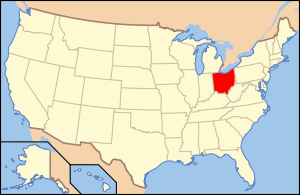Viticulture in Ohio
| Ohio | |
|---|---|

|
|
| Official name: | State of Ohio |
| Appellation type: | US state |
| Year of establishment: | 1803 |
| Viticulture tradition since: | 1823-present |
| Country: | United States |
| Sub-regions: | Grand River Valley AVA , Isle St. George AVA , Lake Erie AVA , Loramie Creek AVA , Ohio River Valley AVA |
| Recognized cultivation area: | 116,096 km² (44,825 sqmi) |
| Grape varieties: | Aurore , Baco Noir , Cabernet Franc , Cabernet Sauvignon , Carmine , Catawba , Cayuga , Chambourcin , Chancellor , Chardonel , Chardonnay , Chelois , Concord , DeChaunac , Delaware , Geisenheim , Gewürztraminer , Ives Noir , Kerner , La Crosse , Landot Noir , Lemberger , Léon Millot , Maréchal Foch , Merlot , Niagara , Pinot Gris , Pinot Meunier , Pinot Noir , Rayon d'Or , Reliance , Riesling , Sangiovese , Sauvignon Blanc , Seyval Blanc , Steuben , Traminette , Vidal Blanc , Vignoles , Zweigelt |
| Number of wineries: | over 40 |
Viticulture in Ohio refers to viticulture in the American state of Ohio . Under American law, every state and county is by definition a protected designation of origin and need not be recognized as such by the Bureau of Alcohol, Tobacco, Firearms and Explosives .
The first vineyards were created with American vines. Viticulture has been documented since 1823 when horticultural expert Nicholas Longworth planted areas with the Alexander and Isabella varieties . In 1825 areas followed with the Catawba grape variety, which had become the most popular variety in the state by 1860. The city of Cincinnati developed into one of the most important wine trading centers in the United States.
During the time of Prohibition , however, viticulture in the region came to a complete standstill and only recovered very slowly. Today more than 40 wineries are registered again and five designations of origin have been defined.
See also
Individual evidence
- ↑ a b Appellation America (2007). "Ohio: Appellation Description" . Last access to this page on May 24, 2008.
literature
- André Dominé (Ed.): Wine . Tandem Verlag, Königswinter 2007, ISBN 978-3-8331-4344-1 .
- Bruce Cass, Jancis Robinson : The Oxford Companion to the Wine of North America . Oxford University Press, Oxford et al. 2000, ISBN 0-19-860114-X .